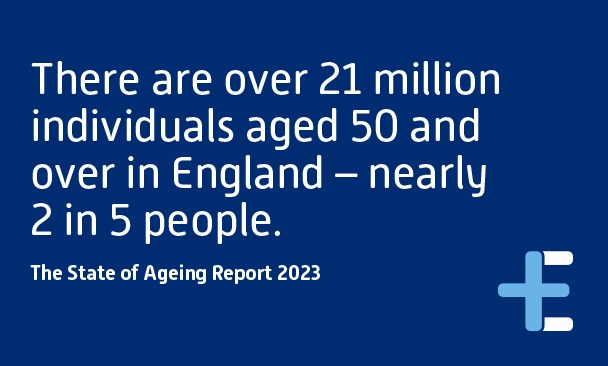Sight After Sixty
23 September 2024
One of the key themes of this week’s National Eye Health campaign is Sight After Sixty.

One of the key themes of this week’s National Eye Health campaign is Sight After Sixty.
As people grow older, they experience changes in their eyesight which can affect daily activities and overall quality of life. Understanding these changes and taking proactive steps to manage them can significantly help to preserve vision and ensure a healthy, active lifestyle into later life.
According to the findings of the 2021 Census, there are over 15.5 million people aged 60 or over in the UK, making up 23% of the population. Today’s increased level of life expectancy means that millions more of us are living into our 70s, 80s, 90s – and beyond. This is borne out by the Centre for Ageing Better’s recent report The State of Ageing which indicates that the country’s population of people aged 80 and over is set to more than double from 3 to 6 million in the next 40 years.

How Vision Changes With Age
Several age-related conditions can impact vision. Presbyopia, the gradual loss of the eye’s ability to focus on close objects, is common to all adults after the ages of 40 – 50 and require the use of spectacles. Other conditions include glaucoma, cataracts and age-related macular degeneration (AMD), which affects central vision and can affect activities like reading and driving.
Preventive Measures
Regular eye tests are crucial for detecting and managing age-related vision changes. Other steps that people can take to protect their vision for longer are:
- Eat nutritiously – for example, include fruit and vegetables every day plus fish and nuts which are high in omega-3 and omega-6 fatty acids
- Manage diabetes and high blood pressure as these are both conditions that may cause eye problems if ignored
- Wear sunglasses and a brimmed hat to protect eyes from the sun’s harmful UV rays
- Stop smoking as tobacco use can increase the risk of eye problems like cataracts and AMD
- Taking frequent breaks from prolonged screen usage can help to avoid eye strain and headaches. The 20/20/ 20 rule recommends taking a break of at least 20 seconds, every 20 minutes and to look at least 20 feet away
Some general hints and tips about eye protection can be found in the Eye Safety section of the RNIB website.
Adapting to Vision Changes
By staying informed and proactive about eye health, people over sixty can continue to enjoy an active, fulfilling life with clear vision. Regular check-ups and lifestyle adjustments play key roles in preserving sight and enhancing quality of life in later years. Taking full advantage of adaptive technologies, such as magnifying devices and specialised lighting are also useful options for improving daily life for anyone experiencing vision issues.
The Importance of Regular NHS Eye Tests
People over the age of 60 are entitled to a NHS funded eye exam, usually every two years. These are essential for early detection of conditions like glaucoma and cataracts and can prevent avoidable vision loss. If illness or disability means someone is housebound, then it may be possible for them to have their NHS eye test at home.
In partnership with Carers UK, Carers Trust Age UK and Public Health England, the NHS has published a guide called A Practical Guide to Healthy Ageing which includes an eye health section.